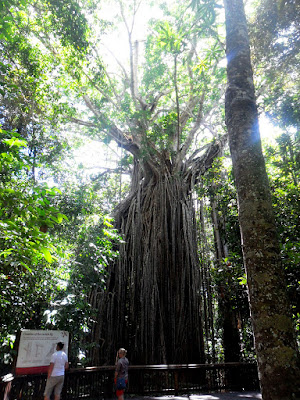Photos tell some of its tale
By Vic Midyett
Moristotle & Co. appreciates a good picture. A friend of mine in northern Queensland, in the Atherton Tableland west of Cairns, took these two photographs recently. The parakeet visits a tree at his family’s home a lot. Wild parakeets of many different varieties and colors are prolific in Australia.
The Atherton Tableland is a fertile plateau, part of the Great Dividing Range, Australia’s most substantial mountain range and the third longest land-based range in the world.
My friend’s place is close to a very large lake, which he walks to every day. This is another photo he took a while back in one of the lake’s “fingers.”
I love the pelicans on the lake, and the bird aflight, and I believe the three birds perched in the tree are hawks, probably looking for fish near the surface to swoop up.
The Atherton Tableland Wikipedia article mentions the Cathedral Fig Tree. Shirley and I saw it while we were in the region, and I took several photos, because the tree’s location and all the other growth around it make it impossible to get a picture of the whole tree.
By Vic Midyett
Moristotle & Co. appreciates a good picture. A friend of mine in northern Queensland, in the Atherton Tableland west of Cairns, took these two photographs recently. The parakeet visits a tree at his family’s home a lot. Wild parakeets of many different varieties and colors are prolific in Australia.
The Atherton Tableland is a fertile plateau, part of the Great Dividing Range, Australia’s most substantial mountain range and the third longest land-based range in the world.
My friend’s place is close to a very large lake, which he walks to every day. This is another photo he took a while back in one of the lake’s “fingers.”
I love the pelicans on the lake, and the bird aflight, and I believe the three birds perched in the tree are hawks, probably looking for fish near the surface to swoop up.
The Atherton Tableland Wikipedia article mentions the Cathedral Fig Tree. Shirley and I saw it while we were in the region, and I took several photos, because the tree’s location and all the other growth around it make it impossible to get a picture of the whole tree.
 |
| See also the Wikipedia entry on the curtain fig tree, where you can read the sign shown in this photograph, or for convenience click here. |
| Copyright © 2017 by Vic Midyett |





Wow, that is one hell of a fig tree. I would be afraid to eat anything that came off it however. It does look a little evil to me. (smile)
ReplyDeleteEd (and others), after original publication, I added a caption to the photograph that shows people milling around the fig tree. The caption provides a link to the Wikipedia entry, "Curtain fig tree," which includes a photograph of the sign the people are looking at (photo of sign).
ReplyDeleteha ha.. Ed, I am thinking I read somewhere that this particular species of fig tree does not produce figs as we know them.
ReplyDeleteA.K.A. the "Strangler Fig". I first saw them in Hawaii, where they were a fad in the 19th century, and became an invasive alien. I saw one example that completely canopied a five acre city park. Mark Twain himself planted one....
ReplyDeleteChuck, they may not be the same. That is, the list of species under Wikipedia's entry for "Strangler fig" doesn't include the species (Ficus microcarpa) given for the curtain fig.
DeleteVery interesting, Chuck. Thanks for the added info. And thanks for your added info too, Morris. Personally, I don't know.
ReplyDeleteG'day Vic Sue and I are staying at a new little park not far from the tree
ReplyDeleteBear
Bear, can you take another photo or two, to send to Vic, to send to me?
DeleteWill try to get some photos for you if this misty rain clears away
DeleteBear
Here, Bear, are four of your very recent photos of the fig tree; thanks for submitting them!
DeletePhoto 1
Photo 2
Photo 3
Photo 4
Hey wow, Bear!! How about that. Good on ya, mate! I presume it's in that interesting little town nearby. Great to hear that and great to hear about you. I've been wondering what has happened to you since you left the other area.
ReplyDeleteIts about 4KMs west of Yungaburra on a maize farm there is about 20 sites
DeleteBear
Oh, now that sounds very nice, Bear. When you can, email me some pics of that too if you would.
ReplyDeleteBy the way, this fig tree is believed to be over 500 years old!
ReplyDelete